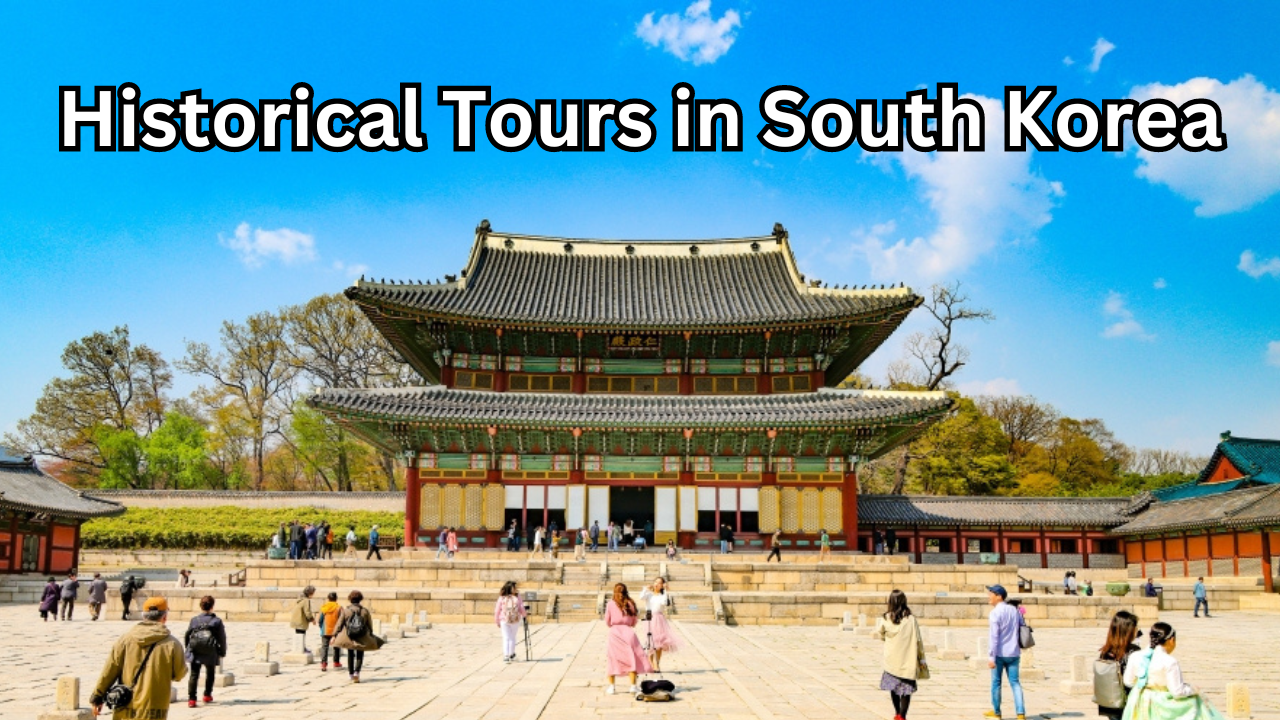Table of Contents
Introduction
South Korea, a country known for its vibrant culture and rapid modernization, also boasts a rich historical tapestry that spans thousands of years. From ancient kingdoms to royal dynasties and pivotal 20th-century events, Korea’s history is intricately woven into its landscape, architecture, and cultural practices. Historical tours in South Korea offer a unique opportunity to delve into this heritage, providing insights into the nation’s past and its enduring traditions.
Exploring historical tours in South Korea allows visitors to walk through time, experiencing the grandeur of royal palaces, the tranquility of traditional villages, and the solemnity of significant war memorials. Whether it’s the meticulously preserved hanok houses of Bukchon, the majestic Gyeongbokgung Palace in Seoul, or the ancient temples of Gyeongju, each destination tells a story of Korea’s evolution and resilience.
This guide aims to highlight some of the most remarkable historical sites across South Korea. From bustling Seoul to the serene countryside, each location offers a unique glimpse into the country’s rich historical narrative. Join us as we embark on a journey through South Korea’s past, exploring the cultural treasures that have shaped its present and continue to inspire its future.
Overview of Historical tours in South Korea
South Korea’s history is a mosaic of ancient traditions, dynastic kingdoms, and cultural transformations. The earliest Korean civilizations date back to the Gojoseon kingdom, established around 2333 BCE. Over the centuries, Korea saw the rise and fall of influential dynasties such as the Silla, Goryeo, and Joseon. Each dynasty contributed significantly to the cultural and architectural legacy that still shapes the nation today.
The Silla Kingdom, known for unifying the Korean Peninsula in the 7th century, left behind remarkable artifacts and architectural marvels, particularly in Gyeongju, its ancient capital. The Goryeo Dynasty, from which the name “Korea” is derived, is remembered for its advancements in printing and Buddhism, epitomized by the exquisite Tripitaka Koreana woodblocks.
The Joseon Dynasty, which ruled for over five centuries until the late 19th century, is celebrated for its Confucian ideals, scientific achievements, and cultural developments. Iconic structures such as Gyeongbokgung Palace and the royal shrines in Seoul stand as testaments to Joseon’s enduring influence.
Modern South Korea seamlessly blends its historical heritage with contemporary culture, offering a unique juxtaposition of past and present. The preservation of historical sites and the continuation of traditional practices highlight the country’s commitment to honoring its heritage while embracing the future.
Importance of Historical Tours in Understanding Korean History
Historical tours play a crucial role in understanding and appreciating Korea’s rich past. These tours provide immersive experiences that go beyond textbooks, allowing visitors to engage directly with the sites and artifacts that define Korean history.
- Cultural Connection: Visiting historical sites helps foster a deeper connection with Korean culture. Walking through ancient palaces, traditional villages, and sacred shrines provides a tangible link to the customs, beliefs, and lifestyles of Korea’s ancestors.
- Educational Value: Historical tours offer educational insights into Korea’s past. Guided tours, in particular, provide detailed narratives and historical context that enhance the learning experience, making complex historical events and figures more accessible and relatable.
- Preservation Awareness: Engaging in historical tours raises awareness about the importance of preserving cultural heritage. Visitors learn about the efforts to maintain and restore historical sites, fostering a sense of responsibility towards cultural conservation.
- Broader Perspective: Understanding the historical context of Korea’s development offers a broader perspective on its current societal structure, values, and international relationships. It highlights how historical events have shaped contemporary South Korean identity and global standing.
- Cultural Appreciation: Historical tours encourage cultural appreciation and respect. By experiencing the grandeur and intricacies of Korean historical sites, visitors gain an appreciation for the craftsmanship, artistry, and architectural brilliance of past generations.
In essence, historical tours in South Korea are not just about sightseeing; they are journeys through time that enrich one’s understanding of the nation’s heritage, instill respect for its traditions, and inspire a deeper appreciation for its cultural identity.
Gyeongbokgung Palace
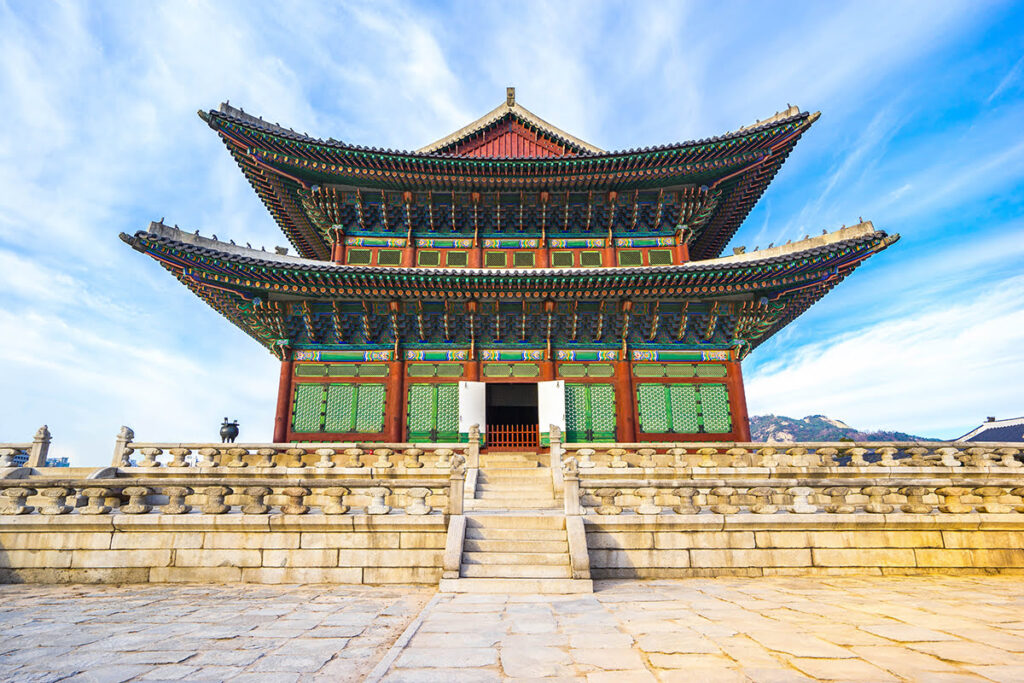
Gyeongbokgung Palace, often referred to as the “Palace Greatly Blessed by Heaven,” is the largest and most iconic of the Five Grand Palaces built during the Joseon Dynasty. Constructed in 1395, three years after the Joseon Dynasty was founded, Gyeongbokgung served as the main royal residence and the heart of government for many centuries.
Historical Significance
Gyeongbokgung Palace stands as a powerful symbol of Korea’s royal heritage. It was the principal palace for the Joseon kings and the primary site for state affairs, including official ceremonies and administrative functions. Despite suffering extensive damage during the Japanese invasions in the late 16th century and the Korean War, the palace has undergone significant restoration efforts to revive its former glory.
Architectural Highlights
- Geunjeongjeon Hall: This is the main throne hall where the king conducted state affairs, held court sessions, and welcomed foreign envoys. The hall’s grandeur is emphasized by its elevated stone platform and intricate wooden carvings.
- Gyeonghoeru Pavilion: Situated on an artificial island within a picturesque pond, this pavilion was used for royal banquets and special events. Its serene setting and elegant architecture make it one of the palace’s most photographed spots.
- Hyangwonjeong Pavilion: Located on a small island within a pond in the northern part of the palace grounds, this hexagonal pavilion is accessible via a beautiful arched bridge. It exemplifies the Joseon Dynasty’s appreciation for nature and tranquility.
- National Palace Museum and National Folk Museum: These museums, located within the palace grounds, offer deeper insights into Korea’s royal history and traditional culture through extensive collections of artifacts, artworks, and historical documents.
Cultural Experiences
Visitors to Gyeongbokgung Palace can partake in various cultural activities that enhance the historical experience:
- Changing of the Guard Ceremony: This colorful re-enactment of the traditional royal guard-changing ceremony occurs multiple times daily at the main gate, Gwanghwamun. The ceremony features guards dressed in vibrant, traditional uniforms and is accompanied by traditional Korean music.
- Hanbok Rental: Wearing a hanbok, the traditional Korean attire, allows visitors to immerse themselves fully in the historical atmosphere. Many shops near the palace offer hanbok rentals, providing an opportunity to explore the palace grounds in traditional dress.
- Guided Tours: Guided tours are available in multiple languages, providing detailed historical context and stories that bring the palace’s history to life. These tours offer invaluable insights into the significance of various buildings and artifacts.
Practical Information
- Location: Situated in the heart of Seoul, Gyeongbokgung Palace is easily accessible by public transportation. The nearest subway station is Gyeongbokgung Station on Line 3.
- Opening Hours: The palace is open daily except Tuesdays, with varying hours depending on the season. It is advisable to check the official website for current hours and any special events or closures.
- Admission: Entrance fees are modest, and discounted tickets are available for children, students, and seniors. Combined tickets for multiple palaces can also be purchased.
Visiting Gyeongbokgung Palace offers a unique opportunity to step back in time and experience the grandeur of Korea’s royal past. It is a must-see destination for anyone interested in Korean history, culture, and architecture.
Bukchon Hanok Village
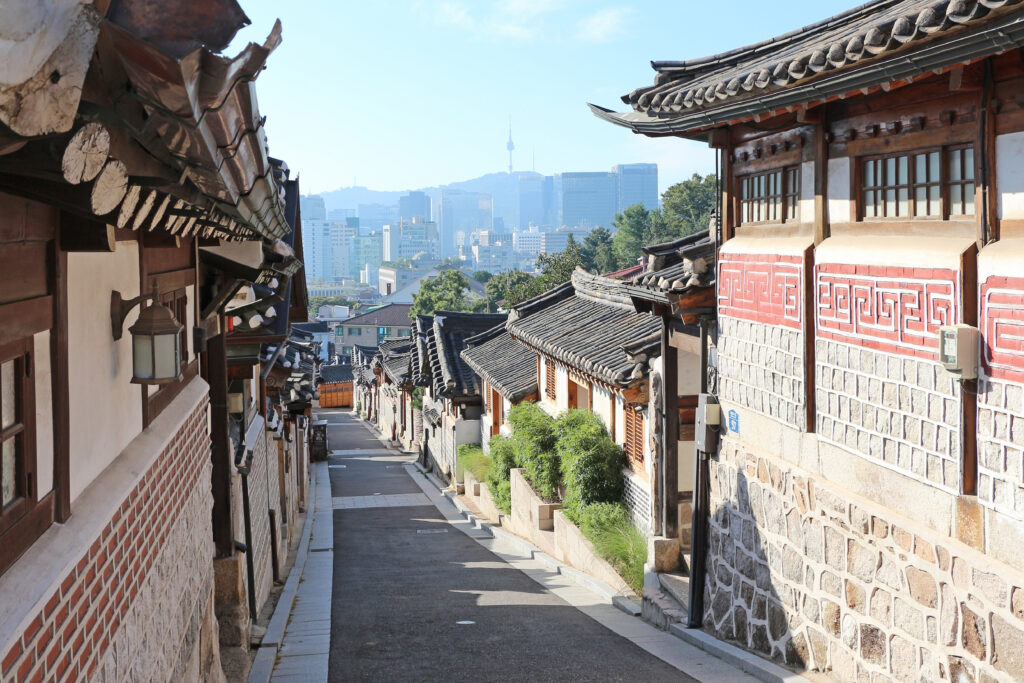
Nestled between Gyeongbokgung Palace, Changdeokgung Palace, and Jongmyo Shrine, Bukchon Hanok Village in Seoul is a remarkable preservation of Korea’s architectural heritage. This traditional village, situated in the heart of the capital, offers a glimpse into the lifestyle of the Joseon Dynasty’s nobility. Bukchon, which means “northern village,” is renowned for its collection of hanok, traditional Korean houses, and has become a significant cultural and historical attraction.
Historical Significance
Bukchon Hanok Village is historically significant as it was originally home to high-ranking government officials and aristocrats during the Joseon Dynasty. The area is a living museum, providing insight into traditional Korean residential architecture and urban living. The village’s layout, with its narrow alleys and tightly packed hanoks, reflects the urban planning principles of the Joseon era.
Architectural Highlights
- Hanok Houses: The hanoks in Bukchon are distinguished by their unique architectural features, including wooden frames, tiled roofs, and ondol (underfloor heating) systems. These houses are designed to harmonize with nature, using natural materials and integrating indoor and outdoor spaces seamlessly.
- Bukchon Traditional Culture Center: This center offers various cultural programs and workshops where visitors can learn about traditional Korean crafts, tea ceremonies, and more. It serves as an educational hub, preserving and promoting Korea’s intangible cultural heritage.
- Eight Scenic Views of Bukchon: The village is famous for its “Eight Scenic Views,” a series of picturesque spots that provide stunning views of the hanok rooftops against the backdrop of modern Seoul. These viewpoints are popular with photographers and offer a serene contrast to the bustling city.
Cultural Experiences
Visitors to Bukchon Hanok Village can engage in a range of cultural activities that enrich their understanding of traditional Korean life:
- Hanbok Rental: Renting a hanbok and strolling through the village in traditional attire is a popular activity. This allows visitors to immerse themselves in the historical atmosphere and take memorable photos.
- Cultural Workshops: Many hanoks have been converted into cultural centers offering workshops on Korean calligraphy, traditional crafts like knot tying (maedeup), and Korean cooking classes. These hands-on experiences provide a deeper appreciation of Korean traditions.
- Tea Houses: The village is dotted with charming tea houses where visitors can enjoy traditional Korean teas and snacks. These tea houses often feature serene interiors and garden views, offering a peaceful retreat from the city’s hustle.
Practical Information
- Location: Bukchon Hanok Village is located in Jongno-gu, central Seoul. It is easily accessible by public transportation, with Anguk Station on Line 3 being the nearest subway station.
- Opening Hours: The village itself is open to the public all year round, but specific attractions such as cultural centers and museums may have their own operating hours. It’s recommended to check the schedules of individual sites.
- Admission: While there is no entrance fee to wander through the village, some cultural centers and workshops may charge for participation.
Responsible Tourism
As Bukchon Hanok Village is a residential area, visitors are encouraged to be respectful of the local community. This includes keeping noise levels down, not trespassing on private property, and being mindful of the residents’ privacy.
Exploring Bukchon Hanok Village offers a unique opportunity to experience a living piece of Korea’s history. It is a place where the past and present coexist, providing a tranquil escape and a deeper understanding of Korean culture and heritage.
Changdeokgung Palace and Secret Garden
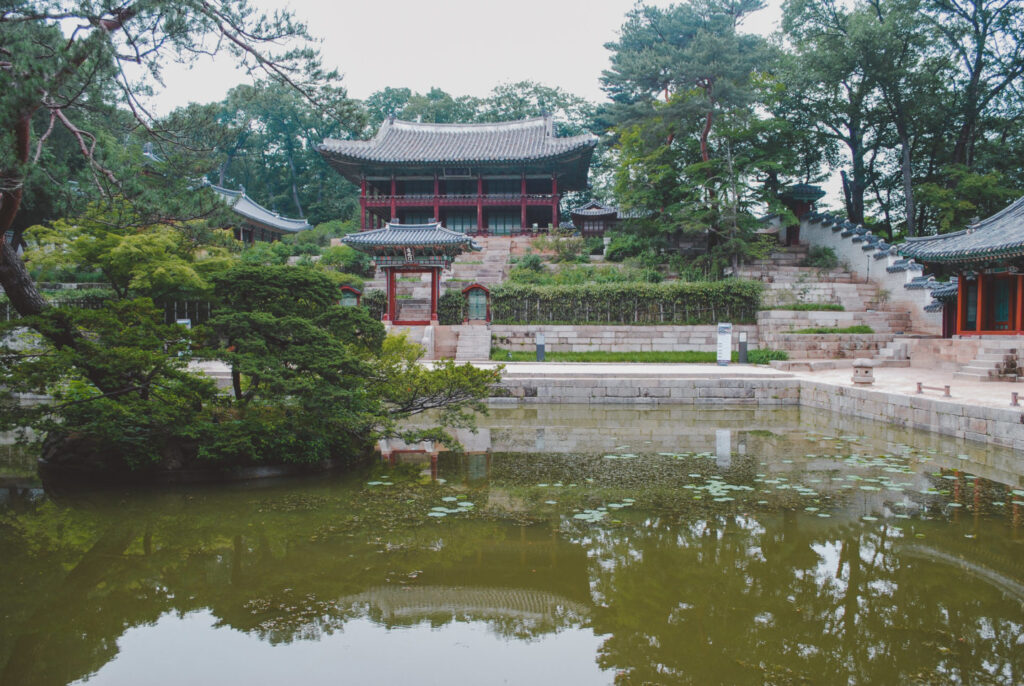
Changdeokgung Palace, one of the Five Grand Palaces built during the Joseon Dynasty, is celebrated for its harmonious integration with the natural landscape. Located in Seoul, this UNESCO World Heritage Site is renowned for its architectural beauty and the enchanting Huwon, also known as the Secret Garden. Built in 1405, Changdeokgung served as a royal residence for over 270 years and remains one of the best-preserved palaces in Korea.
Historical Significance
Changdeokgung Palace holds a special place in Korean history due to its unique design and historical relevance. Unlike other palaces that follow a rigid, symmetrical layout, Changdeokgung was constructed to blend seamlessly with the surrounding topography. This approach reflects the Confucian principle of harmonizing with nature, which was a guiding philosophy during the Joseon Dynasty.
The palace served as the primary residence for many Joseon kings and was the site of numerous important state affairs. It also witnessed significant historical events, including the Japanese invasions in the late 16th century and the subsequent restorations that followed.
Architectural Highlights
- Injeongjeon Hall: The main throne hall of Changdeokgung, Injeongjeon, is where major state ceremonies and official meetings were held. The hall’s grandeur is accentuated by its raised stone platform, intricate wooden carvings, and the majestic throne.
- Seonjeongjeon Hall: This hall was used as the king’s council hall, where he met with officials to discuss state matters. It is notable for its unique blue-tiled roof and elegant design.
- Nakseonjae Complex: A quieter, more intimate area of the palace, Nakseonjae was built in the 19th century as a residence for royal family members. It features simple yet elegant architecture, reflecting the king’s preference for a modest lifestyle.
- Donhwamun Gate: The main gate of Changdeokgung, Donhwamun, is the oldest structure in the palace, dating back to 1412. Its two-story pavilion provides a commanding view of the palace grounds.
The Secret Garden (Huwon)
The Secret Garden, also known as Huwon, is the highlight of Changdeokgung Palace. Covering approximately 78 acres, the garden was originally designed as a private retreat for the royal family. It is an exquisite example of traditional Korean garden design, emphasizing natural beauty and serenity.
- Buyongjeong Pavilion and Buyongji Pond: This picturesque pavilion and lotus pond area is one of the garden’s most iconic spots. The tranquil setting was used for leisure activities, including poetry readings and banquets.
- Juhamnu Pavilion: Situated on a hillside, this pavilion served as a library and study for the king. It offers stunning views of the garden and exemplifies the Confucian ideal of scholarly retreat.
- Yeongyeongdang Residence: Built to host special events and entertain foreign envoys, this area features traditional wooden architecture and expansive courtyards.
- Aeryeonjeong Pavilion: Nestled by a small stream, this pavilion was a place for rest and contemplation, embodying the peaceful spirit of Huwon.
Cultural Experiences
Visitors to Changdeokgung Palace and the Secret Garden can enhance their experience through various cultural activities:
- Guided Tours: To fully appreciate the historical and architectural significance, guided tours are highly recommended. These tours provide detailed insights into the palace’s history, design, and the stories behind its various structures.
- Seasonal Events: The palace hosts several cultural events throughout the year, including traditional music and dance performances, which bring the historical setting to life.
- Hanbok Experience: Wearing a hanbok, the traditional Korean attire, while exploring the palace adds an immersive and authentic touch to the visit.
Practical Information
- Location: Changdeokgung Palace is situated in Jongno-gu, Seoul. It is easily accessible via public transportation, with Anguk Station on Line 3 being the nearest subway station.
- Opening Hours: The palace is open year-round, with varying hours depending on the season. The Secret Garden has separate tour times, and advance reservations are recommended due to limited slots.
- Admission: There are separate entrance fees for the palace and the Secret Garden, with discounts available for children, students, and seniors. Combined tickets for multiple palaces are also available.
Changdeokgung Palace and its Secret Garden offer a serene and historically rich escape from the bustling city, allowing visitors to experience the elegance and tranquility of Korea’s royal heritage.
Jongmyo Shrine
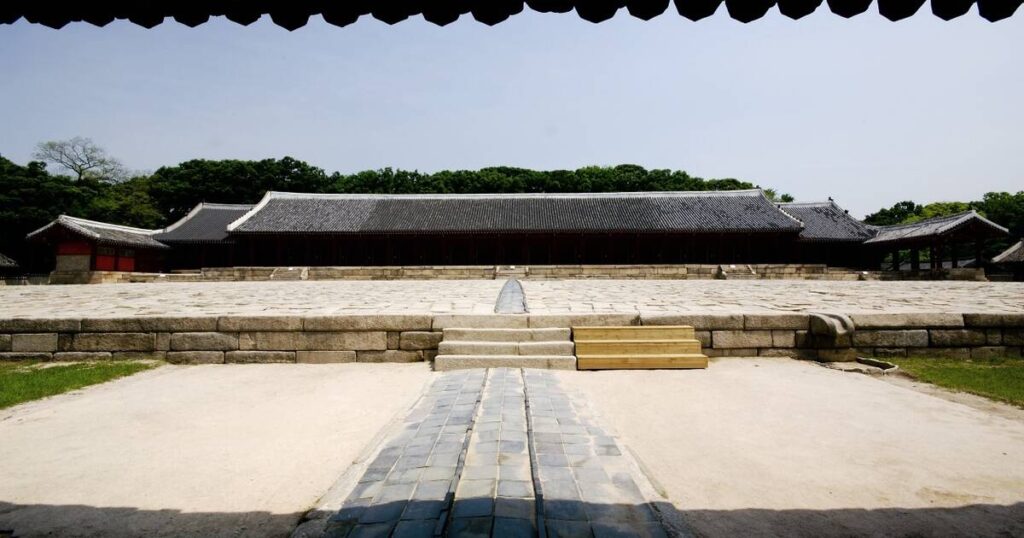
Jongmyo Shrine, located in Seoul, is one of South Korea’s most revered cultural sites and a UNESCO World Heritage Site. Dedicated to the deceased kings and queens of the Joseon Dynasty, Jongmyo is the oldest and most authentic of the Confucian royal shrines. Built in 1394 by King Taejo, the founder of the Joseon Dynasty, the shrine is a profound testament to Korea’s Confucian traditions and its reverence for ancestry.
Historical Significance
Jongmyo Shrine holds immense historical and cultural significance as it houses the spirit tablets of the Joseon kings and queens, commemorating their contributions and virtues. It embodies the Confucian value of filial piety and the emphasis on ancestral worship, which were central to the governance and social structure of the Joseon Dynasty.
The shrine was constructed according to strict Confucian principles, emphasizing simplicity, harmony, and solemnity. It served as the primary venue for the Jongmyo Jerye, a royal ancestral rite conducted to honor the spirits of the Joseon royalty. This ritual, which includes music, dance, and offerings, is still performed today, preserving a tradition that has lasted for over six centuries.
Architectural Highlights
- Jeongjeon Hall: The main hall of Jongmyo Shrine, Jeongjeon, is the largest wooden structure in Korea and houses the spirit tablets of 49 kings and queens. Its austere yet majestic design reflects the Confucian ideals of modesty and respect. The hall’s length and the number of spirit chambers are unparalleled, signifying its importance.
- Yeongnyeongjeon Hall: This auxiliary hall, also known as the Hall of Eternal Peace, contains the spirit tablets of other royal family members. Its design is similar to Jeongjeon but on a smaller scale, maintaining the same principles of Confucian architecture.
- Mangmyoru Pavilion: Located near Jeongjeon Hall, this pavilion was used by the king to await the preparation of the rituals. It offers a quiet, reflective space that underscores the solemnity of the ancestral rites.
- Gongsindang Hall: This hall is dedicated to the meritorious subjects who played significant roles during the Joseon Dynasty. It highlights the importance of loyalty and service to the state.
Cultural Experiences
Visitors to Jongmyo Shrine can immerse themselves in the cultural and historical essence of the site through various activities and experiences:
- Jongmyo Jerye: Held annually on the first Sunday in May, this Confucian ritual is a major cultural event. It includes traditional music (Jongmyo Jeryeak) and dance, performed in honor of the royal ancestors. Witnessing this ceremony offers a rare glimpse into Korea’s rich cultural heritage and living traditions.
- Guided Tours: To fully appreciate the historical and cultural significance of Jongmyo Shrine, guided tours are highly recommended. These tours provide detailed explanations of the shrine’s history, architecture, and the rituals performed.
- Cultural Workshops: Various workshops and educational programs are available for visitors interested in learning more about Confucian traditions, ancestral rites, and Korean history.
Practical Information
- Location: Jongmyo Shrine is located in Jongno-gu, Seoul, near the bustling district of Insadong. It is easily accessible via public transportation, with Jongno 3-ga Station on Lines 1, 3, and 5 being the nearest subway station.
- Opening Hours: The shrine is open throughout the year, but hours may vary by season. It is advisable to check the official website for current hours and any special events or closures.
- Admission: Entrance fees are modest, with discounts available for children, students, and seniors. Combined tickets for multiple historical sites in Seoul, including Changdeokgung Palace, are also available.
Responsible Tourism
As Jongmyo Shrine is a sacred site, visitors are encouraged to respect the solemn atmosphere and the cultural practices observed here. This includes dressing modestly, maintaining quietude, and refraining from any disruptive behavior.
Jongmyo Shrine is not just a historical monument; it is a living testament to Korea’s Confucian heritage and its enduring respect for the past. A visit to Jongmyo offers a profound insight into the spiritual and cultural foundations of the Joseon Dynasty, making it a must-see destination for anyone interested in Korean history and culture.
Historical Sites Outside Seoul
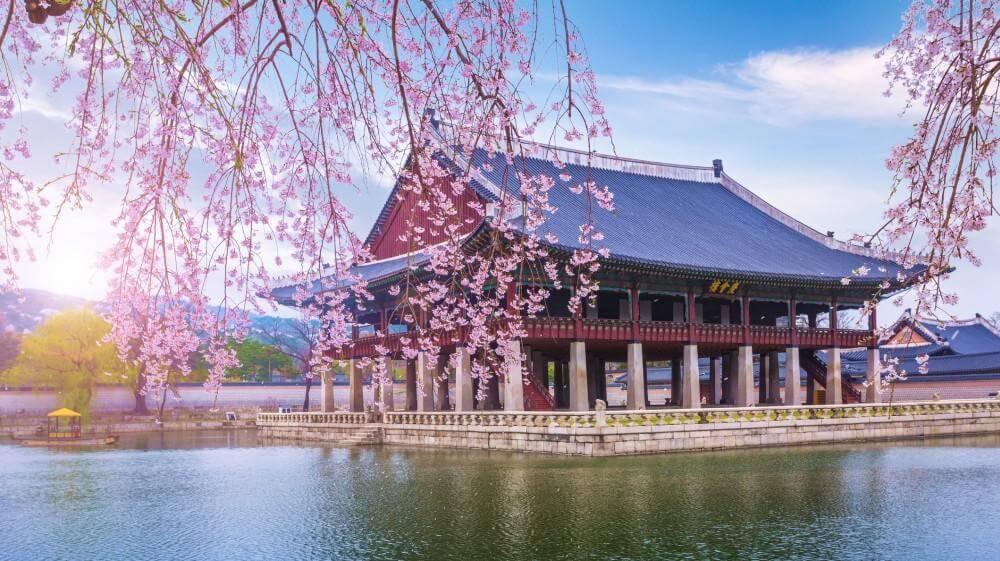
Suwon Hwaseong Fortress
Suwon Hwaseong Fortress, located in Suwon, South Korea, is a stunning example of late 18th-century military architecture and a UNESCO World Heritage Site. Built between 1794 and 1796 by King Jeongjo of the Joseon Dynasty, the fortress was constructed as a tribute to his father, Prince Sado, and as a demonstration of the king’s filial piety and aspirations to create a new city that would serve as a political and economic hub.
Historical Significance
Suwon Hwaseong Fortress is historically significant for its innovative design and the use of advanced construction techniques. King Jeongjo’s vision was to create a fortress that combined the best elements of both Eastern and Western military architecture, ensuring robust defense capabilities while also serving as a functional urban center.
The construction of the fortress involved the use of contemporary scientific knowledge and technology, including a manual written by Jeong Yak-yong, a prominent scholar and engineer. This manual, titled “Hwaseong Seongyeokuigwe,” meticulously documented the construction process and the use of specialized equipment, highlighting the advanced engineering practices of the time.
Architectural Highlights
- Paldalmun Gate: One of the four main gates of the fortress, Paldalmun is notable for its impressive wooden superstructure and stone base. It serves as the southern entrance to the fortress and is surrounded by bustling markets, reflecting the fortress’s role as a center of commerce.
- Hwaseomun Gate: Located on the western side, this gate is distinguished by its robust defensive features, including a semi-circular barbican, which provided an additional layer of protection against invaders.
- Seojangdae (Western Command Post): This command post offers a panoramic view of the surrounding area, allowing for strategic oversight and defense. It is a two-story structure that was used to observe enemy movements and coordinate military operations.
- Hwahongmun Gate: Known for its beautiful arched design, Hwahongmun is a water gate that controls the flow of the Suwoncheon Stream through the fortress. The gate’s seven arched openings create a picturesque scene and serve a practical purpose in water management.
- Hwaryeongjeon Shrine: Dedicated to King Jeongjo’s father, Prince Sado, this shrine is an important cultural site within the fortress. It highlights the filial piety and reverence that motivated the construction of Hwaseong.
Cultural Experiences
Visitors to Suwon Hwaseong Fortress can engage in a variety of cultural activities that bring the historical site to life:
- Traditional Archery: The fortress offers opportunities to experience traditional Korean archery, a martial art practiced by the soldiers who once defended Hwaseong. Visitors can try their hand at shooting arrows while learning about the history and techniques of this ancient skill.
- Hwaseong Trolley Tour: A trolley resembling a royal vehicle from the Joseon Dynasty provides guided tours around the fortress. This is an excellent way to explore the extensive site comfortably while receiving informative commentary on its history and significance.
- Nighttime Tours and Performances: The fortress often hosts nighttime tours and traditional performances, such as martial arts demonstrations and reenactments of historical events. These activities provide a dynamic and immersive experience of Hwaseong’s historical ambiance.
Practical Information
- Location: Suwon Hwaseong Fortress is located in Suwon, Gyeonggi Province, approximately 30 kilometers south of Seoul. It is easily accessible by public transportation, with Suwon Station on Line 1 and the Bundang Line being the nearest subway station. Local buses and taxis are available for the short trip from the station to the fortress.
- Opening Hours: The fortress is open year-round, but hours may vary depending on the season. It’s advisable to check the official website or local tourist information for the most up-to-date opening times and any special events or closures.
- Admission: There is an entrance fee to access the fortress, with discounts available for children, students, and seniors. Combination tickets that include other nearby attractions, such as the Suwon Hwaseong Museum, can also be purchased.
Responsible Tourism
As a historical and cultural heritage site, visitors are encouraged to respect the fortress and its surroundings. This includes following guidelines, not climbing on structures, and being mindful of the natural environment.
Suwon Hwaseong Fortress is a remarkable blend of history, culture, and architectural ingenuity. A visit to this site offers not only a journey through Korea’s rich past but also an appreciation of the innovative spirit that characterized the late Joseon Dynasty. Whether through guided tours, cultural activities, or simply walking the ancient walls, exploring Suwon Hwaseong Fortress provides a profound and enriching experience.
DMZ Tour (Demilitarized Zone)
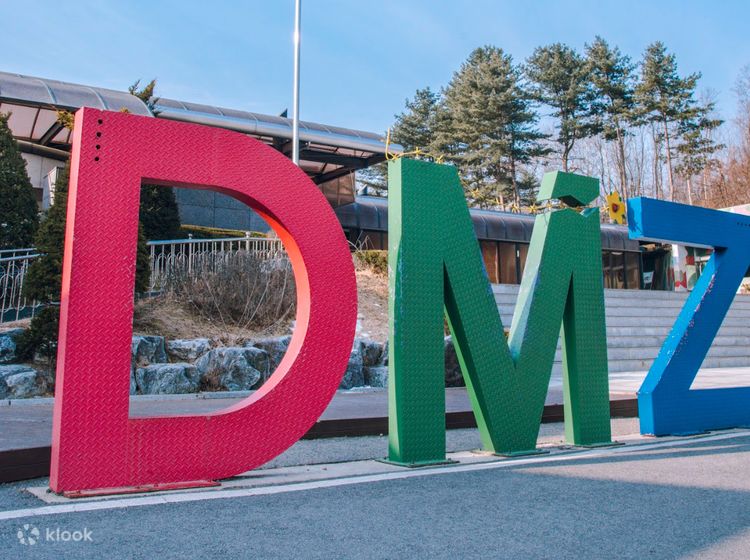
The Demilitarized Zone (DMZ) historical tours in South Korea is one of the most iconic and historically significant areas on the Korean Peninsula. Spanning approximately 250 kilometers and serving as a buffer zone between North and South Korea, the DMZ is a symbol of the division that has persisted since the Korean War. A DMZ tour offers a unique and insightful experience into the complex history, politics, and current state of affairs on the Korean Peninsula.
Historical Context
The DMZ holds immense historical significance, primarily stemming from the Korean War (1950-1953), which resulted in a temporary armistice rather than a formal peace treaty. The DMZ was established as part of the armistice agreement, creating a demilitarized strip of land that separates North and South Korea. Despite its name, the DMZ is heavily fortified and remains one of the most heavily militarized borders in the world.
Key Highlights of a DMZ Tour
- Third Infiltration Tunnel: One of the most intriguing stops on a DMZ tour is the Third Infiltration Tunnel. Discovered in 1978, this tunnel was dug by North Korea as part of an infiltration strategy. Visitors can descend into the tunnel and explore its narrow passages, gaining insight into the tensions and security measures along the border.
- Dora Observatory: Perched atop Mount Dora, the Dora Observatory offers panoramic views of the DMZ and glimpses into North Korea. Visitors can use binoculars to observe landmarks such as the Kaesong Industrial Complex and the North Korean propaganda village of Kijong-dong.
- Joint Security Area (JSA) / Panmunjom: The JSA, located within the DMZ, is where inter-Korean diplomatic discussions take place. Visitors to the JSA can step into the blue meeting rooms that straddle the border, providing a rare opportunity to stand in North Korean territory while remaining in South Korea.
- DMZ Museum: The DMZ Museum, located near the Third Infiltration Tunnel, offers exhibits and artifacts that document the history of the DMZ, the Korean War, and the ongoing division between North and South Korea. It provides valuable context and insights into the geopolitical complexities of the region.
Cultural and Political Insights
A DMZ tour goes beyond military installations and historical sites; it provides a deeper understanding of Korean culture, politics, and the aspirations for reunification:
- Cross-border Relations: Visitors learn about the delicate inter-Korean relations and the efforts made to promote dialogue and cooperation despite ongoing tensions.
- Geopolitical Significance: The DMZ is a focal point of international attention and plays a crucial role in global security discussions. Understanding its geopolitical significance helps visitors grasp the broader implications of the Korean Peninsula’s division.
- Hope for Reunification: Many visitors leave the DMZ tour with a sense of hope for eventual peace and reunification. The tour serves as a reminder of the human cost of division and the shared aspirations for a unified Korea.
Practical Information
- Tour Options: There are several tour options available, ranging from half-day tours focused on specific sites to full-day tours that provide a comprehensive overview of the DMZ and its significance.
- Booking: Due to high demand and limited access to certain areas, it is advisable to book DMZ tours in advance through authorized tour operators or government-approved agencies.
- Restrictions: Visitors should be aware that certain areas of the DMZ are restricted, and photography may be prohibited in certain locations. It is essential to follow the instructions of tour guides and military personnel at all times.
Important Considerations
- Safety: While the DMZ is a controlled area, visitors should adhere to safety protocols and guidelines provided by tour operators. The area remains a militarized zone, and caution is advised.
- Sensitivity: The DMZ tour touches on sensitive political and historical issues. Visitors are encouraged to approach the experience with respect, empathy, and an open mind, understanding the complexities of the situation.
A DMZ tour offers a poignant and thought-provoking exploration of the Korean Peninsula’s past, present, and future. It provides a rare glimpse into a divided nation and the enduring hopes for peace, reconciliation, and eventual reunification.
Gyeongju
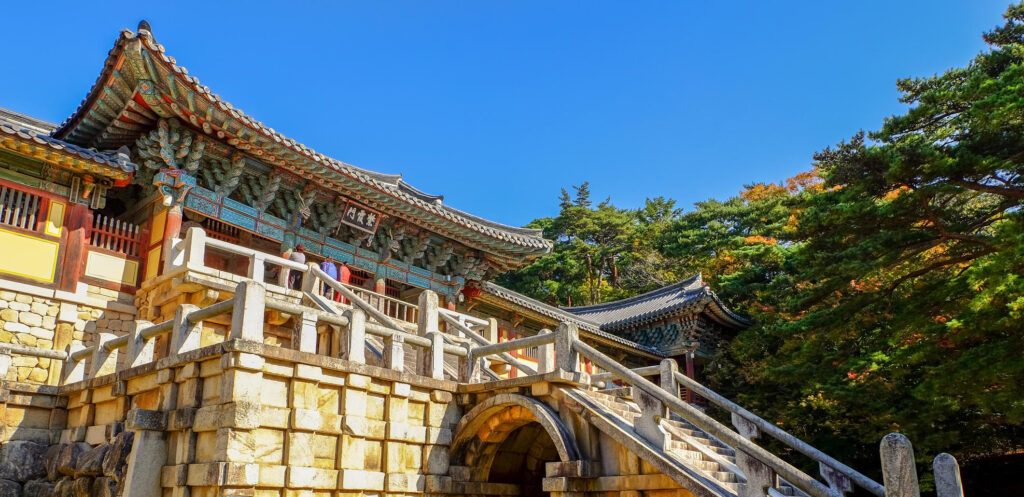
Gyeongju, often referred to as the “Museum Without Walls,” is a city steeped in history, culture, and natural beauty. Located in the southeastern part of South Korea, Gyeongju served as the capital of the ancient Silla Kingdom (57 BCE – 935 CE) for over a millennium. Today, it stands as a testament to Korea’s rich heritage, boasting a plethora of archaeological sites, temples, tombs, and cultural artifacts.
Historical Significance
- Silla Kingdom Heritage: Gyeongju was the heart of the Silla Kingdom, a period marked by significant cultural and political achievements. The kingdom’s influence extended beyond the Korean Peninsula, with trade and diplomatic relations reaching as far as China and Japan.
- Bulguksa Temple: A UNESCO World Heritage Site, Bulguksa Temple is a masterpiece of Silla architecture and Buddhist art. Built in the 8th century, it symbolizes the zenith of Silla’s cultural and religious expression.
- Seokguram Grotto: Adjacent to Bulguksa Temple, Seokguram Grotto houses a monumental granite Buddha statue. The grotto, meticulously carved into the mountainside, is a marvel of ancient engineering and spiritual devotion.
- Daereungwon Tomb Complex: This vast burial site contains royal tombs, including the Cheonmachong (Heavenly Horse Tomb), which houses exquisite artifacts and offers insights into Silla’s burial customs and artistic achievements.
Cultural Experiences
- Gyeongju National Museum: A treasure trove of Silla artifacts, the museum showcases pottery, gold crowns, Buddhist relics, and historical documents. It provides a comprehensive overview of Silla’s cultural legacy.
- Anapji Pond: Originally part of a royal palace complex, Anapji Pond is a serene oasis surrounded by landscaped gardens and ancient ruins. It offers a glimpse into Silla’s architectural aesthetics and leisure activities.
- Traditional Crafts Village: Visitors can explore Hanok (traditional Korean houses) and engage in hands-on activities such as pottery making, weaving, and traditional tea ceremonies. This immersive experience fosters an appreciation for Silla’s artisanal traditions.
Natural Beauty
- Namsan Mountain: A scenic hiking destination, Namsan Mountain is dotted with Buddhist relics, including rock carvings and pagodas. The mountain’s trails offer panoramic views of Gyeongju and its surrounding countryside.
- Yangdong Folk Village: A UNESCO World Heritage Site, Yangdong Folk Village preserves traditional Korean architecture and rural life. Visitors can wander through thatched-roof houses, Confucian academies, and picturesque landscapes.
- Gyeongju Cherry Blossom Festival: In spring, Gyeongju’s cherry blossoms bloom in abundance, creating a breathtaking spectacle. The city comes alive with festivals, cultural performances, and outdoor activities during this vibrant season.
Practical Information
- Transportation: Gyeongju is accessible by train, bus, or car from major cities like Seoul and Busan. Within the city, bicycles and local buses are convenient for exploring its attractions.
- Accommodation: Gyeongju offers a range of accommodations, from traditional guesthouses (hanok) to modern hotels and resorts. Staying in a hanok provides an immersive cultural experience.
- Local Cuisine: Gyeongju’s culinary scene showcases traditional Silla dishes, such as Hwangnam-ppang (red bean-filled pastries) and Gyeongju bread. Local markets offer fresh produce, street food, and regional specialties.
Conclusion
Gyeongju’s blend of ancient history, cultural heritage, and natural splendor makes it a captivating destination for history enthusiasts, cultural explorers, and nature lovers alike. Whether wandering through millennia-old temples, admiring intricate artifacts, or soaking in the beauty of cherry blossoms, Gyeongju offers a journey through Korea’s illustrious past and vibrant present.
Andong Hahoe Folk Village
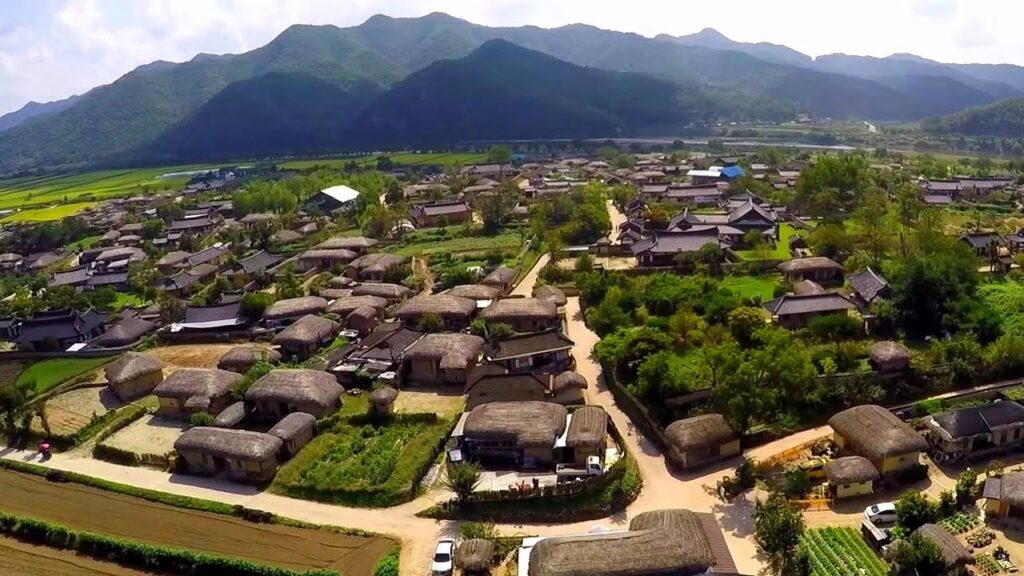
Andong Hahoe Folk Village, nestled in the picturesque embrace of the Nakdong River in South Korea, is a living testament to the country’s traditional culture and rural way of life. Designated as a UNESCO World Heritage Site, Hahoe Village preserves centuries-old traditions, architecture, and customs, offering visitors a captivating journey back in time.
Historical Significance
- Joseon Dynasty Heritage: Hahoe Village dates back to the Joseon Dynasty (1392-1910) and has retained its traditional layout and architectural style. The village’s name, “Hahoe,” means “village enveloped by the river,” a fitting description of its natural setting.
- Hahoe Mask Dance: The village is renowned for its Hahoe Mask Dance, a traditional performance that combines elements of shamanistic rituals, satire, and storytelling. The masks, carved from wood and representing various characters, are central to this cultural tradition.
- Yangban (Noble Class) Residences: Hahoe Village is home to well-preserved yangban houses, belonging to the noble class of the Joseon era. These traditional houses, with their thatched roofs and wooden architecture, reflect the lifestyle and social hierarchy of the time.
Cultural Experiences
- Hahoe Mask Museum: Visitors can explore the Hahoe Mask Museum to learn about the history and significance of the village’s iconic masks. The museum showcases a diverse collection of masks and offers insights into their roles in Korean culture.
- Traditional Crafts Workshops: Hahoe Village hosts workshops where visitors can experience traditional Korean crafts such as mask making, pottery, and weaving. These hands-on activities provide a deeper appreciation for the village’s artisanal heritage.
- Byeongsanseowon Confucian Academy: Located near Hahoe Village, Byeongsanseowon is a Confucian academy established in the 16th century. It reflects the scholarly pursuits and Confucian ideals that shaped Korean society during the Joseon Dynasty.
Natural Beauty
- Nakdong River Cruise: A leisurely cruise along the Nakdong River offers stunning views of Hahoe Village’s riverside setting, lush landscapes, and historic landmarks. It is a tranquil way to appreciate the village’s natural beauty.
- Buyongdae Cliff: Rising above the village, Buyongdae Cliff provides panoramic vistas of Hahoe Village and the surrounding countryside. It is a popular spot for photography and enjoying the serenity of rural Korea.
Practical Information
- Access: Andong Hahoe Folk Village is accessible from Andong City by bus or taxi. It’s recommended to check local transportation options and schedules before visiting.
- Accommodation: Visitors can opt to stay in traditional guesthouses (hanok) within Hahoe Village for an immersive experience of rural Korean life. Advance reservations are advisable during peak tourist seasons.
- Cultural Events: The village hosts cultural events and performances throughout the year, including the Hahoe Mask Dance Festival, where visitors can witness traditional dances and cultural performances.
Conclusion
Andong Hahoe Folk Village is a cherished cultural gem that offers a glimpse into Korea’s rural heritage and traditional way of life. From the captivating Mask Dance to the serene beauty of the Nakdong River, every aspect of the village invites visitors to connect with Korea’s past and appreciate its enduring cultural legacy. A visit to Hahoe Village is a journey back in time, where history, art, and nature converge to create an unforgettable experience.
Jeonju Hanok Village
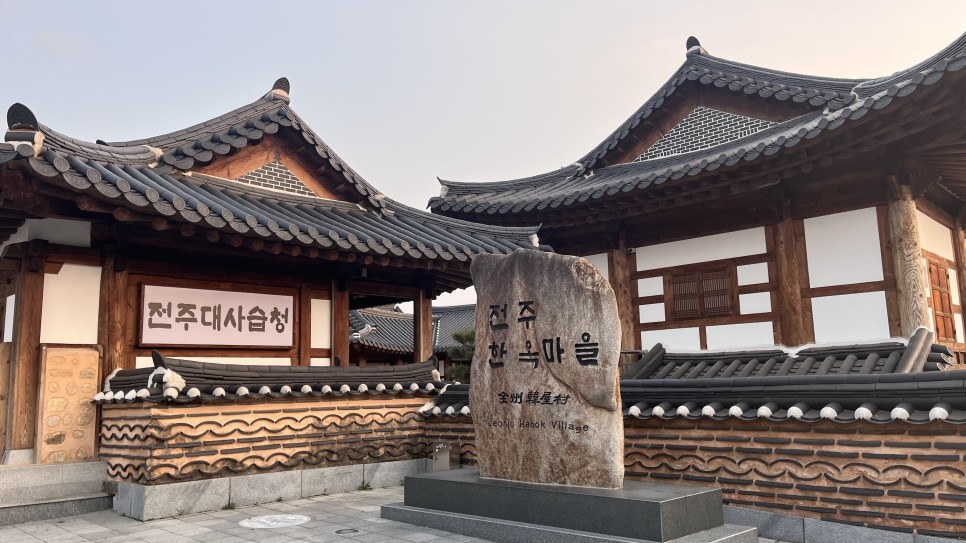
Jeonju Hanok Village, located in the heart of Jeonju city in South Korea, is a cherished cultural enclave that showcases the beauty and heritage of traditional Korean architecture. With its well-preserved hanok houses, vibrant cultural scene, and delectable cuisine, Jeonju Hanok Village offers visitors a captivating journey into Korea’s past and present.
Historical Significance
- Joseon Dynasty Roots: Jeonju Hanok Village traces its roots back to the Joseon Dynasty (1392-1910) and is renowned for its concentration of hanok houses. These traditional Korean houses feature elegant wooden structures, tiled roofs, and distinctive courtyard layouts, reflecting centuries-old architectural principles.
- Birthplace of Bibimbap: Jeonju is famed as the birthplace of bibimbap, a beloved Korean dish consisting of rice, assorted vegetables, meat, and a spicy sauce. Visitors can savor authentic bibimbap at local eateries within the Hanok Village.
Cultural Experiences
- Hanbok Experience: Many shops in Jeonju Hanok Village offer hanbok (traditional Korean attire) rentals, allowing visitors to dress in period costumes and explore the village in style. It’s a fun way to immerse oneself in Korean culture and capture memorable photos.
- Traditional Crafts and Workshops: Artisans in Jeonju Hanok Village practice traditional crafts such as pottery, calligraphy, and embroidery. Visitors can participate in workshops to learn these time-honored skills and create their own handcrafted souvenirs.
- Jeonju Hanji Culture Center: Hanji refers to traditional Korean paper made from mulberry bark. The Hanji Culture Center in the village showcases the art of hanji-making and offers workshops where visitors can create paper crafts and artworks.
Culinary Delights
- Bibimbap Alley: A gastronomic paradise, Bibimbap Alley in Jeonju Hanok Village is lined with restaurants and eateries specializing in bibimbap. Each establishment offers its unique twist on this iconic dish, ensuring a flavorful culinary experience.
- Makgeolli Street: Makgeolli, a traditional Korean rice wine, is a popular beverage in Jeonju. Makgeolli Street features numerous bars and pubs serving an array of makgeolli varieties, paired with savory jeon (pan-fried dishes).
Cultural Heritage Sites
- Gyeonggijeon Shrine: This historic shrine houses the portrait of King Taejo, the founder of the Joseon Dynasty. The shrine’s architecture and serene surroundings make it a significant cultural landmark in Jeonju.
- Omokdae and Imokdae: These scenic pavilions atop Mount Omok offer panoramic views of Jeonju Hanok Village and the surrounding countryside. They are ideal spots for enjoying sunset vistas and appreciating the village’s charm from a different perspective.
Practical Information
- Access: Jeonju Hanok Village is easily accessible from Jeonju Station by bus or taxi. The village itself is pedestrian-friendly, allowing visitors to explore its narrow alleys and hanok-lined streets on foot.
- Accommodation: For an authentic experience, consider staying in a hanok guesthouse within the village. These traditional accommodations offer a glimpse into Korean lifestyle and hospitality.
- Events and Festivals: Jeonju Hanok Village hosts various cultural events and festivals throughout the year, including traditional music performances, lantern festivals, and culinary celebrations.
Conclusion
Jeonju Hanok Village embodies the timeless charm of Korea’s cultural heritage, blending historical architecture, culinary delights, and artistic traditions into a vibrant tapestry of experiences. Whether wandering through its quaint alleys, savoring local delicacies, or trying your hand at traditional crafts, a visit to Jeonju Hanok Village promises an enriching and memorable immersion into Korean culture and history.
Danyang Eight Scenic Views
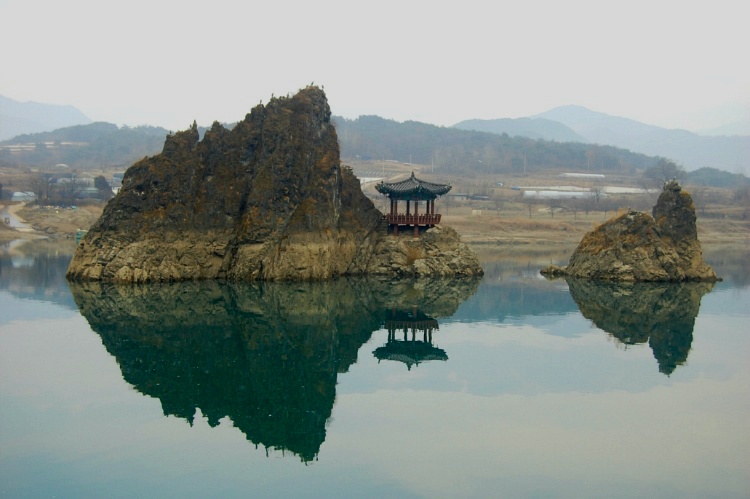
Danyang, nestled in the heart of South Korea’s Chungcheongbuk Province, is renowned for its breathtaking natural landscapes and picturesque vistas. The Danyang Eight Scenic Views, also known as “Danyang Palgyeong” in Korean, encompass a series of stunning sights that showcase the region’s diverse beauty and cultural heritage.
1. Dodamsambong Peaks
The Dodamsambong Peaks, meaning “three peaks with two rocks,” are iconic limestone formations rising majestically from the Namhan River. The juxtaposition of the peaks and the flowing river creates a harmonious and picturesque scene, making it one of Danyang’s most recognizable landmarks.
2. Chungjuho Lake
Chungjuho Lake, the second largest reservoir in South Korea, offers serene waters surrounded by rolling hills and verdant forests. The lake’s tranquil beauty is enhanced by the changing colors of the seasons, making it a popular destination for boating, fishing, and leisurely walks along its shores.
3. Sainam Rock
Sainam Rock, also known as the “Fairy Rock,” is a natural wonder that resembles a reclining woman gazing at the sky. Legend has it that a fairy fell in love with a mortal man and transformed into the rock, symbolizing eternal love and devotion.
4. Ondal Tourist Site
Ondal Tourist Site is steeped in folklore and history, with attractions such as Ondal Cave, Ondal Hot Springs, and the legend of General Ondal and Princess Pyeonggang. The site offers a blend of natural beauty, cultural heritage, and recreational activities.
5. Mancheonha Skywalk
Perched high above the Mancheonha Valley, the Mancheonha Skywalk provides awe-inspiring views of the surrounding mountains and forests. Walking along the transparent glass floor of the skywalk offers a thrilling experience for adventurers and nature enthusiasts.
6. Gosu Cave
Gosu Cave is a limestone cave complex adorned with stalactites, stalagmites, and underground streams. The cave’s mystical atmosphere and geological formations make it a fascinating destination for cave exploration and ecological discovery.
7. Danyang Bridge
Spanning the Namhan River, Danyang Bridge offers panoramic views of the river valley and surrounding mountains. The bridge’s architectural design and scenic backdrop make it a popular spot for photography and sightseeing.
8. Ondal Hwaom Temple
Ondal Hwaom Temple, nestled amidst tranquil forests, is a serene Buddhist temple that embodies peace and spirituality. The temple’s traditional architecture, serene gardens, and religious artifacts create a serene retreat for visitors seeking solace and cultural enrichment.
Practical Information
- Access: Danyang is accessible by bus or car from major cities like Seoul and Daejeon. Local transportation within Danyang is available for visiting the scenic spots.
- Accommodation: Danyang offers a range of accommodations, including hotels, guesthouses, and resorts, catering to different preferences and budgets.
- Seasonal Attractions: Each season in Danyang brings unique charms, from cherry blossoms in spring to vibrant foliage in autumn. Plan your visit according to your preferred seasonal highlights.
Conclusion
The Danyang Eight Scenic Views encapsulate the natural splendor and cultural richness of this enchanting region in South Korea. Whether marveling at limestone peaks, exploring mystical caves, or enjoying tranquil lakeside vistas, Danyang offers a tapestry of experiences that celebrate the beauty and diversity of Korea’s landscapes. A journey to Danyang promises unforgettable encounters with nature’s masterpieces and timeless moments of serenity and wonder.
Practical Tips for Historical Tours
Embarking on a historical tour can be a fascinating and enriching experience, providing insights into the past and deepening your understanding of cultural heritage. Here are some practical tips to enhance your historical tour:
1. Research and Plan Ahead
- Study the History: Familiarize yourself with the historical background of the sites you plan to visit. Understanding the context will enrich your experience and help you appreciate the significance of each location.
- Plan Your Itinerary: Create a detailed itinerary that includes the historical sites, museums, and cultural attractions you wish to explore. Consider factors such as opening hours, admission fees, and travel time between locations.
2. Choose the Right Tour Guide or Audio Guide
- Qualified Guides: If available, opt for guided tours led by knowledgeable and accredited guides who can provide in-depth information and historical context.
- Audio Guides: In the absence of a guide, consider using audio guides or mobile apps that offer audio commentary. These can enhance your understanding while exploring at your own pace.
3. Respect Cultural Etiquette
- Dress Code: Some historical sites may have specific dress codes, especially religious or sacred places. Dress modestly and respectfully to adhere to cultural norms.
- Behavior: Respect local customs, traditions, and rules while visiting historical sites. Maintain a quiet demeanor, refrain from touching artifacts unless allowed, and follow designated pathways.
4. Stay Informed About Safety
- Safety Precautions: Familiarize yourself with safety guidelines and emergency procedures at historical sites. Pay attention to signage and follow instructions from staff or guides.
- Weather Conditions: Check the weather forecast and prepare accordingly, especially if your tour involves outdoor activities or extensive walking.
5. Carry Essential Items
- Water and Snacks: Stay hydrated and carry light snacks to maintain energy levels during your tour.
- Comfortable Footwear: Wear comfortable and sturdy footwear suitable for walking, as historical sites often involve uneven terrain and long distances.
6. Capture Memories Responsibly
- Photography: Respect any photography restrictions at historical sites. Avoid using flash photography in sensitive areas or near delicate artifacts.
- Take Notes: Consider carrying a notebook or using a note-taking app to jot down key points, observations, and memorable experiences during your tour.
7. Engage and Ask Questions
- Interactive Learning: Engage with exhibits, displays, and interactive elements at historical sites. Ask questions and seek clarification from guides or staff to deepen your knowledge.
- Local Insights: Take advantage of opportunities to interact with locals or cultural experts to gain unique perspectives and insights into the historical significance of the sites.
8. Reflect and Appreciate
- Take Time to Reflect: Allocate moments during your tour to pause, reflect, and absorb the historical significance of the sites you visit.
- Appreciate Diversity: Historical tours often showcase diverse perspectives and narratives. Embrace the diversity of heritage and appreciate the complexities of history.
By following these practical tips, you can make the most of your historical tour, engage meaningfully with cultural heritage, and create lasting memories of your exploration into the past.
Importance of Guided Tours for Historical Context
Guided tours play a pivotal role in providing a deeper understanding of historical sites by offering context, insights, and expert knowledge. Here’s why guided tours are essential for gaining historical context:
- Expert Commentary: Knowledgeable guides provide detailed explanations about the historical significance, architectural features, and cultural context of each site. Their expertise adds depth to your experience and helps you appreciate the nuances of history.
- Narrative and Stories: Guides often share captivating stories, anecdotes, and historical narratives that bring the past to life. These narratives offer a human perspective and connect visitors emotionally to the history of the place.
- Contextualization: Guides contextualize historical events within broader historical, cultural, and social contexts. This contextual understanding helps visitors grasp the significance of each site in the larger tapestry of history.
- Interactive Learning: Guided tours often include interactive elements such as discussions, Q&A sessions, and multimedia presentations. These interactive experiences enhance engagement and facilitate a deeper learning experience.
- Access to Restricted Areas: In some cases, guided tours provide access to areas that are not open to the general public. This privileged access allows for a more comprehensive exploration of historical sites.
Recommendations for Participating in Cultural Experiences
Participating in cultural experiences during your travels can enrich your understanding of local traditions, customs, and heritage. Here are some recommendations for engaging in cultural activities:
- Attend Cultural Performances: Seek out traditional music, dance, and theater performances that showcase the region’s cultural heritage. These performances often convey stories, myths, and historical events through artistic expressions.
- Visit Museums and Cultural Centers: Explore museums, cultural centers, and heritage sites to learn about local art, crafts, history, and traditions. Participate in workshops, demonstrations, or guided tours to delve deeper into cultural practices.
- Join Festivals and Celebrations: Participate in festivals, religious ceremonies, and cultural celebrations that take place during your visit. These events offer insights into community rituals, festivities, and cultural practices.
- Interact with Locals: Engage with local communities, artisans, and experts to gain firsthand knowledge about their cultural heritage. Ask questions, listen to stories, and participate in conversations to foster cultural exchange.
- Try Traditional Activities: Take part in traditional activities such as cooking classes, craft workshops, martial arts sessions, or cultural performances. Hands-on experiences allow you to appreciate the skills, techniques, and creativity involved in cultural practices.
Suggestions for Trying Local Cuisine in Different Regions
Exploring local cuisine is an essential aspect of cultural immersion while traveling. Here are some suggestions for trying local cuisine in different regions:
- Research Local Dishes: Before your trip, research the iconic dishes and culinary specialties of the region you’re visiting. Create a list of must-try foods based on local recommendations and reviews.
- Visit Food Markets: Explore local food markets, street vendors, and food stalls to sample a variety of traditional dishes. Food markets offer a vibrant culinary experience and showcase the diversity of regional cuisine.
- Dine at Authentic Restaurants: Seek out authentic restaurants that specialize in local cuisine. Look for establishments frequented by locals, as they often serve traditional dishes prepared with fresh, seasonal ingredients.
- Take Food Tours: Consider joining guided food tours or culinary experiences that introduce you to regional flavors, cooking techniques, and food culture. These tours often include tastings, chef interactions, and insights into culinary traditions.
- Try Regional Specialties: Be adventurous and try regional specialties, including street food, regional delicacies, signature dishes, and traditional desserts. Embrace the diversity of flavors and textures unique to each region.
- Engage with Food Culture: Learn about the cultural significance of local dishes, dining customs, and food rituals. Engage with locals to understand the stories behind the food and its place in regional identity.
By embracing guided tours for historical context in Asia, participating in cultural experiences, and exploring local cuisine, you can deepen your travel experiences, gain cultural insights, and create memorable connections with the places you visit.
Conclusion
In conclusion, embarking on historical tours, engaging in cultural experiences, and exploring local cuisine are integral aspects of immersive travel that enrich our understanding of diverse cultures, traditions, and histories.
Guided tours serve as invaluable tools for providing historical context, offering expert insights, and fostering a deeper connection to the places we visit. They enhance our appreciation for architectural marvels, archaeological sites, and cultural landmarks by contextualizing them within broader historical narratives.
Participating in cultural experiences allows us to engage with local traditions, arts, and customs firsthand, promoting cultural exchange and mutual understanding. By attending performances, visiting museums, and interacting with local communities, we gain a deeper appreciation for the rich tapestry of human heritage.
Exploring local cuisine adds a sensory dimension to our travel experiences, allowing us to savor the flavors, aromas, and stories behind traditional dishes. Sampling regional specialties, visiting food markets, and trying authentic restaurants immerse us in the culinary heritage of each destination.
Ultimately, these experiences not only broaden our knowledge and perspective but also foster respect, empathy, and appreciation for the diversity of our world. They remind us of the interconnectedness of cultures and the importance of preserving and celebrating our shared heritage.
As we continue to explore and learn from the places we visit, may our travels be filled with meaningful connections, memorable experiences, and a deepened sense of cultural awareness and appreciation.
Read more Historical Tours in Japan
